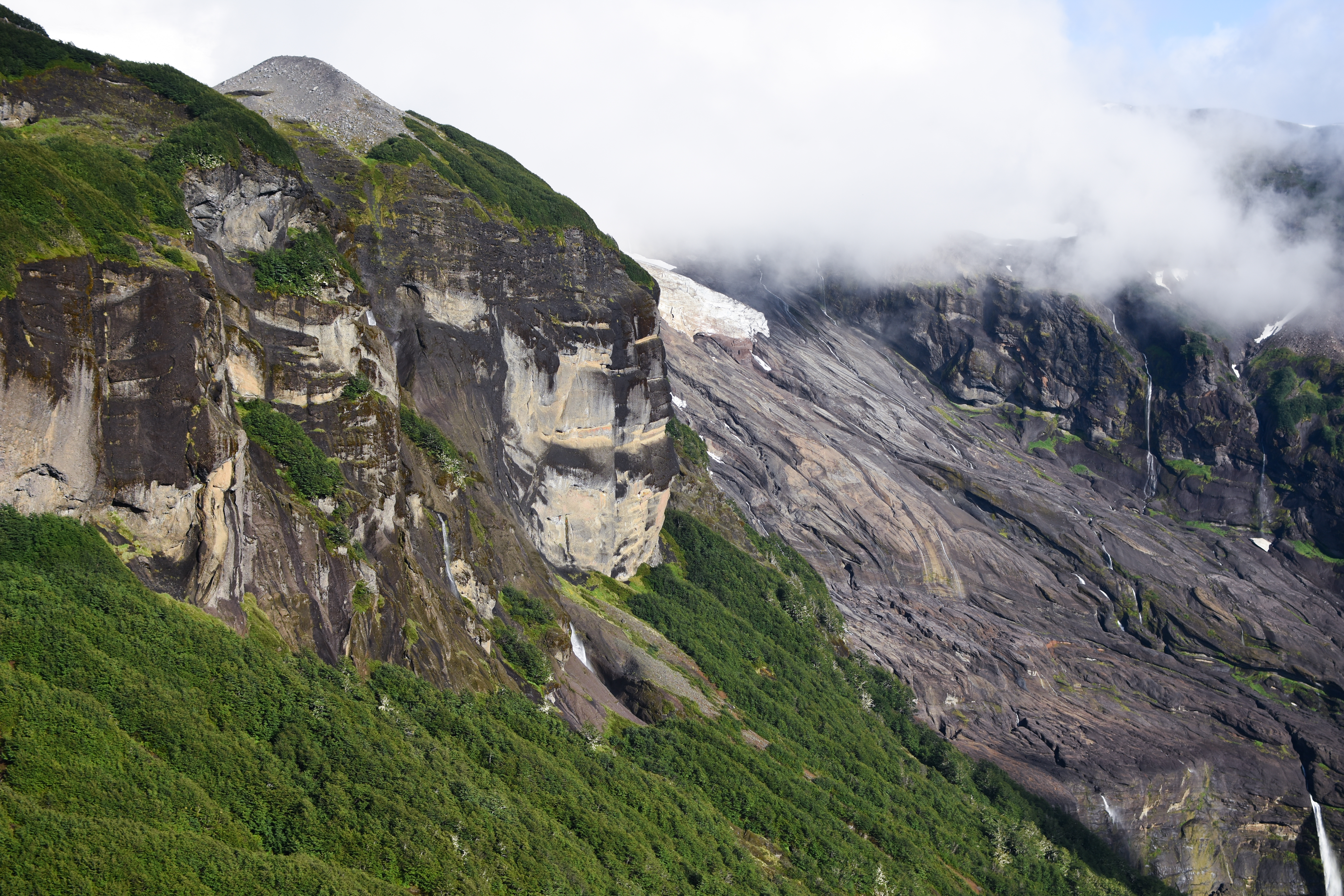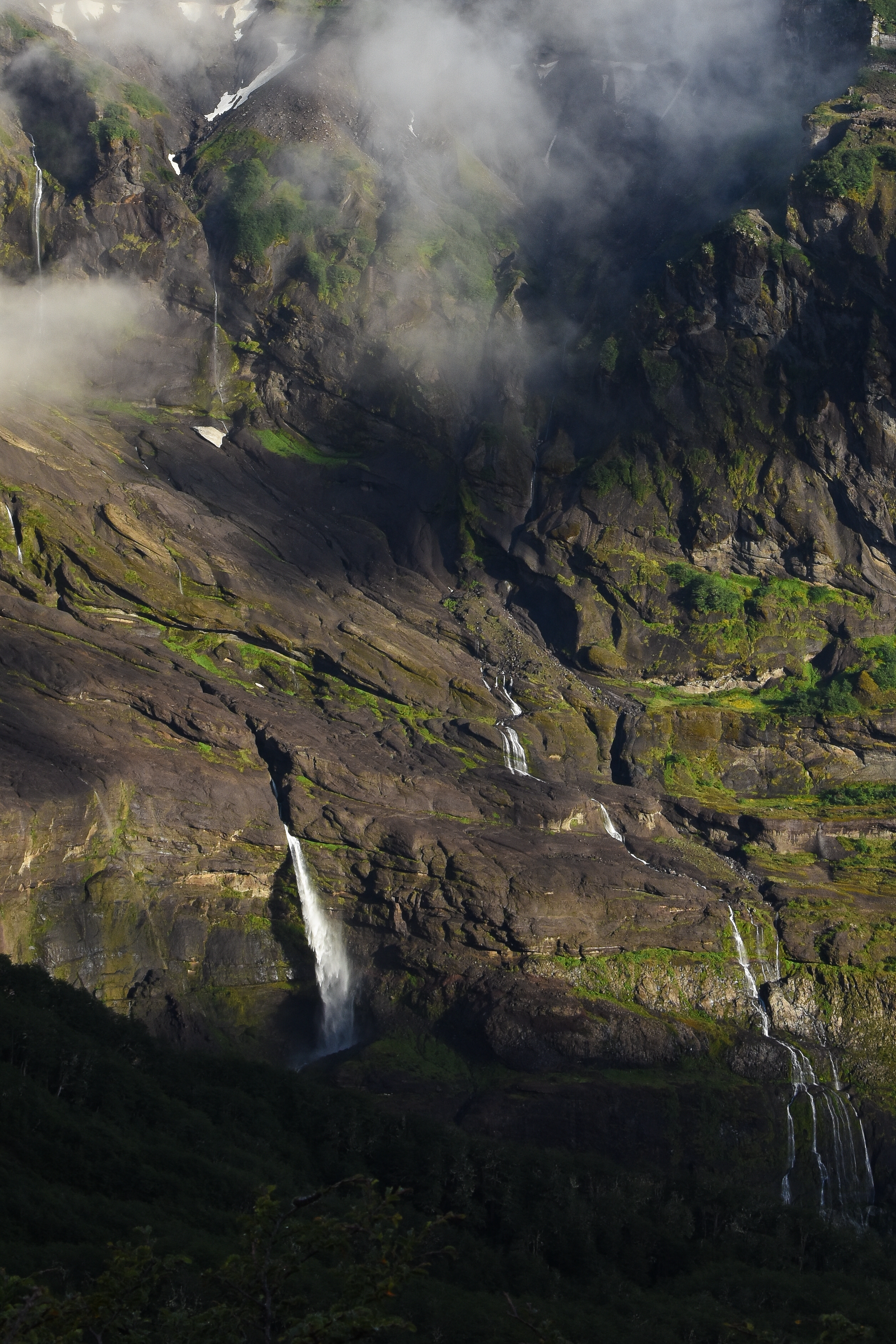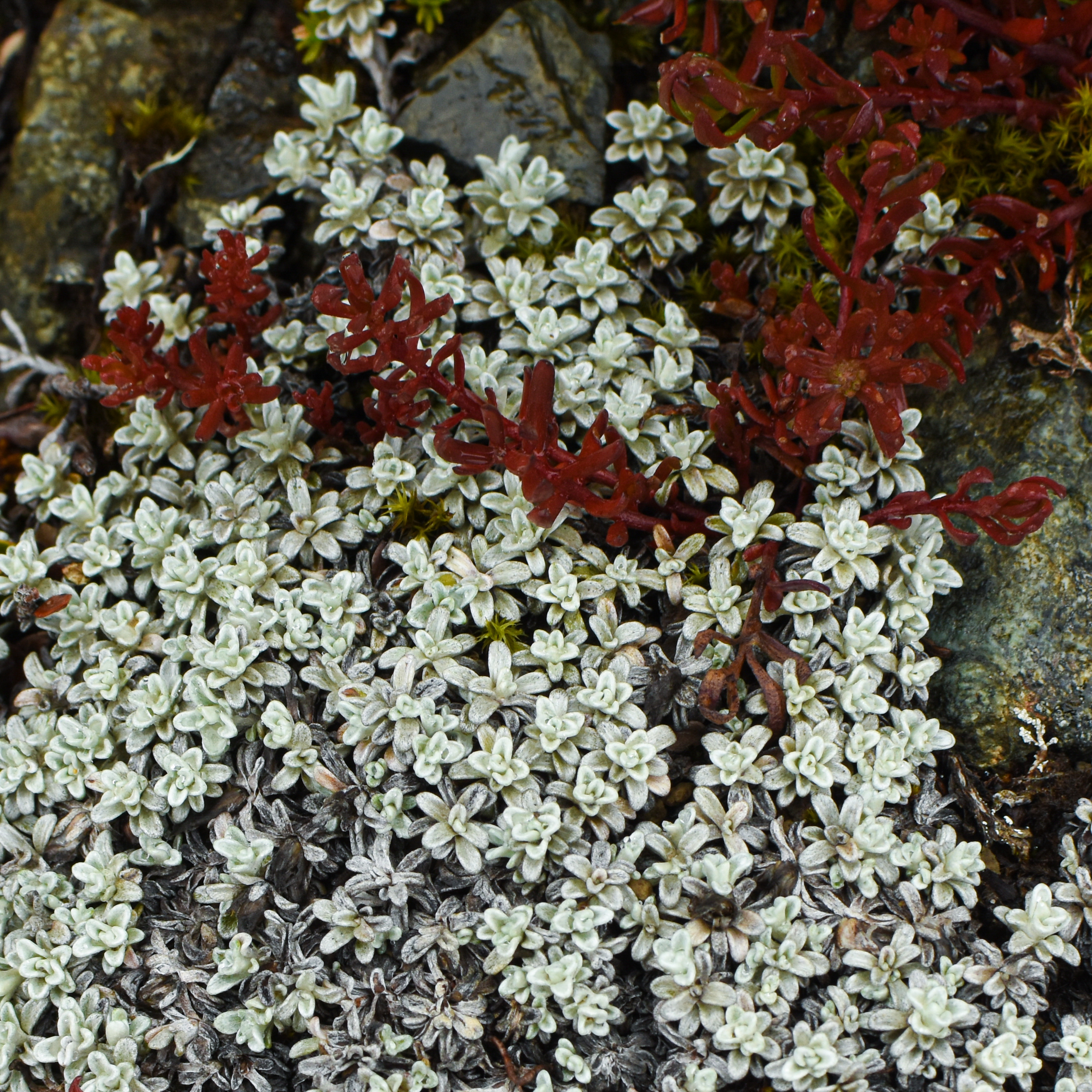I stand at the edge of a blank canvas. Featureless mist swirls in its depths. My gaze hungrily scans the emptiness, but I find only ghosts and shadows. The light pulses: dark to light and back again; the sun is doing its level best to break through the veil. Functionally blind, I must rely on the soundscape to paint a picture for my eyes. The crash of rushing water outlines an invisible waterfall, but is it down there, or over here? The wind inks a sea of rustling leaves, and my mind’s eye embellishes it with hues already hovering on the cusp of autumn. There’s a hollowness to the air, carried by the mists that cling briefly to the hillside then flee at the slightest gasp of wind.
I can feel them, too. The mountains. The glacier-shrouded volcano. Their gravity tugs at me almost as strongly as the Earth’s. I know they’re up there somewhere, just waiting for the misty curtains to drop. They’re old hands at this show now, having performed it every day for fifty million years, but for my part I am literally perched on the edge of my seat. I shiver with cold and anticipation. It’s like I’ve inhaled a giant lungful of cloud, and it has suspended me in time. Now I’m just waiting for the perfect time to exhale.

My untethered mind begins to drift with the clouds, carrying me up and away to a day five years ago in the Chisos mountains of Texas. It was on a day not unlike this one, my twenty-seventh birthday in fact, when I first tested my hand at cloud-waiting. I had climbed three miles into the foggy hills and stepped over half a dozen tarantulas, only to be greeted at the summit by a stubborn wall of mist. Normally I would have turned around and left, but something told me to wait. An hour passed, just me sitting alone on top of a cloud-soaked mountain. And then: clarity. Whatever landscapes I had imagined behind the mist were so far surpassed by the reality. The memory of such fierce gratification rooted me now to my perch. I wait alone, the sole believer that sooner or later the mists will part.
A flurry of movement brings me fully back to the present. Down low – look, there! – the bottom half of the canvas floods with shape and color. Navy and grey burst through the mist, with evergreen and gold sharp on their heels. A tear in the veil, a mile wide and ten long, reveals a wild valley that rambles all the way to Chile.
Just as abruptly, the rip heals, and white pours back into the valley. But now the veil’s power has weakened, and the scene changes nearly with every blink. First white, now grey, now a panorama of vivid primeval glory. Strips of sunlight chase the wily fog up the mountainsides. The wind is so persuasive that it overpowers gravity, reversing the flow of waterfalls so that they pour upwards into the sky.



Paso de las Nubes. I had assumed the name translated to Pass of the Clouds, but within five minutes of my arrival it was clear that this is more a Passage for the Clouds. The same wind that pushes waterfalls straight up has also formed a horizontal cloudfall through the pass. The clouds race towards me through the valley, hurtle upwards through the narrow saddleback on which I stand, and then pour down into the valley at my back. I am a tiny fish, trying to hold my ground as I am battered by misty rapids.
Warmth flees my body the longer I bathe in this torrent of cloud. Fortunately for my frozen fingers, Refugio Rocca is just footsteps away from my perch. I spend the afternoon darting in and out of the surprisingly cozy shelter, drawn in first by the heat then out again by the ever-shifting views. Wall-to-wall plate glass windows aid and abet my capricious migrations. I am so constantly distracted by the mountains that I can barely hold a conversation with my colleagues.



The last time I truly backpacked was with my family on Isle Royale, in 2009. You know, eleven years ago. But when my INTA colleagues asked if I wanted to join a weekend birthday party in a remote refugio on the side of a dead volcano, I was powerless to refuse. I didn’t particularly care that I was wildly unprepared for mountain backpacking. I hastily borrowed a sleeping bag, shoved four times too much food and clothing into my bag, and piled into a raggedy Patagonian jeep headed for the wilderness.
Cerro Tronador is an ancient volcano that can be seen from Bariloche on clear days. Its snowy tip barely peeks over the rim of the closest Andes, like a child eyeing a plate of cookies on the kitchen counter. But the closer peaks and the curvature of the Earth hide the truth of this mountain’s enormity, which only becomes clear once you make your way up the serpentine valleys leading to its base. It rises 3.5 kilometers* above sea level, dwarfing its nearby mountain siblings. It’s cloaked in a perennial ice field miles across. And it houses three fairly ornery dragons…or so I would believe.


I spent half of 2019 in Bariloche, but like a bad neighbor, I had never introduced myself to Tronador until today. And from the first minute I clapped eyes on the volcano, a beautiful love affair was born (may we live happily ever after, in sickness and in health). I would spend the next six weeks trying to live in its shadow, throwing myself at the mercy of anyone with a car.
Did I mention that I was wildly unprepared for mountain backpacking, and that I brought way too much stuff? It seemed a common affliction in our group of four hikers – even just pulling on our packs in the gravel parking lot at Pampa Linda was an ordeal. The first four hours of the hike were kind to us, nice and mostly flat along a frigid river shimmering with my favorite shade of turquoise. My shoulders and upper back screamed regardless, like they were trying to drown out the pleasant gurgling of the river. I, in turn, tried to drown it out with rotating conversations with my German colleague, an Argentine PhD student, and a cheerful older trilingual scientist wearing a jaunty gaucho’s hat, who was by far my favorite since he’s one of those types who constantly spews information about the surrounding forest and words in the local native language.
One of the inevitabilities of hiking in the mountains is that the pleasant valley will eventually end and you’ll be forced to ascend into the heavens. We crawled over the trunks of fallen coihue trees, so large that the parks service just cut steps and handholds into their bodies instead of trying to remove them. I wrenched a dead bamboo cane out of the woods and used it as a third leg, steadying myself against the chunky Patagonian rocks that are never held fast by the dusty soil. I volunteered to bring up the rear of the pack so I could pause at the corner of every switchback and pant, red-faced, cursing and occasionally kicking at the mountains. Like my discomfort makes any difference to them.





Up and up, into the chapparal forest of my now-beloved lenga. I pat them on their twisted little heads as I pass, wishing I could ask them how many winters they have spent clinging to life on this mountain’s edge. Our walking encyclopedia hikes faster than I do, and I only occasionally catch up to him. “Ten more minutes,” he promises, every time I see him. Sure, maybe that’s true for him.
You can take the flatlander out of the flatlands…
We cross alpine marshes, all rich mahogany earth peeking at us through lime green grass. Water pools in the hollows and we have to gingerly leap from rock to log to solid ground, praying that our ungainly backpacks don’t unbalance us and send our boots flying straight into the muck. We toil, always facing the ground or yet another hill in front of us. Mist begins to gather at our backs, and is it that which is making my backpack heavier? The grey light sets the tone for the march and tunnel vision sets in, whether from exertion or thin air I have no idea. One foot in front of the other, although that’s difficult when every single step requires a conscious decision about where to place said foot.
Finally I slither over a muddy boulder and look up to see a faded Tibetan prayer flag strung across a short tunnel of lengas. Peeking down its length I see a bright maroon wall, and I am too tired to say anything, but my already-racing heart leaps with accomplishment. Here in my bubble of mist, only the ground at my feet and this improbable hulk of a shelter are visible, and not for the first time I wonder if it’s all just a hallucination.
Eighty people, this shelter can officially hold, with a tent pad out back. There’s also a delightful humanitarian policy where even if you arrive at this first-come-first-served hostel after it is full, they will always find you a dry place to sleep. The bunk-bed mattresses may be filthy and the walls may be bare plywood, but there is delicious heat and a kitchen staff to cook you a pasta dinner and beer to buy, and after the 14 kilometer hike we just made, these luxuries are akin to a five-star hotel. We peel off our boots and leave them in a pile outside. We literally throw ourselves on the floor, contorting our bodies into whichever stretch our muscles demand, popping Advil as though it will help, trying anything to lessen the discomfort. Nothing works until the balm of the lifting mists, when the view finally numbs all the pain receptors under my skin and I know that it was all worth it.



The climb down the next morning is almost worse, my muscles already aching and my knee joints now taking the brunt of what my thigh muscles handled yesterday. And yet I am buoyed with elation. My wonderful 32-year-old body was able to carry me all the way up into those misty heights so that I could spend a night sleeping on a volcano’s icy shoulder. After the trek up and back, I am one bottle of champagne and one bag of food and a thousand thoughts lighter. I scan the trail margins for the fiery red of wild strawberries, each plant producing a single berry that is no larger than my thumbnail and often half-buried in the dirt. They burst with untamed sweetness, and the miles melt under my feet as I am consumed with my obsessive search.


At the bottom of the climb, a sturdy bridge crosses the raging river filled with glacial meltwater from high above. I throw myself onto my belly in the middle of the bridge and shove my arms into the flow, losing sight of them immediately in the thick glacial flour. My head is next. I dip just the top of my scalp into the aqua water and it sends knives of cold-burning-pain screaming into my skin. I ignore it and scrub my hair, the icy relief overpowering the discomfort. I cup my hands and bring an overflowing bowl of turquoise to my face, splashing myself over-enthusiastically like a filthy parody of a Neutrogena model. I taste salt sluicing from my skin. The next bowl I bring to my lips, imbibing the sweet and pure glacier’s blood, then another, and another.
Baptised by a glacier. Cleansed, inside and out, I pick up my pack and carry on, following my feet into the great unknown.

*8.6 miles for the Yanks
I see my favorite traveling author in this visually-stunning blog!
LikeLike
Fabulous peek into the window of your journeys through life, my dear; well crafted and the pictures are stunning.
now get back to work… (once you get back to your homeland and reconnected to the world)!
Love Dad.
LikeLike
Oh my Jill, this is fabulous. I felt like I put my head in that icy water. Your writing is so beautiful and your pictures are splendid. What a trip. Germany’s gain is our tremendous loss. USA needs women with your brains, beauty and love of life. All the best from your MTU friend ( and Marnie’s Sister)
Mary Agnes Kern CPA
LikeLike